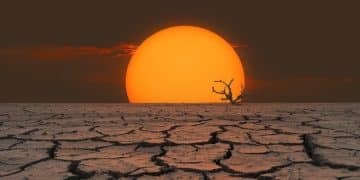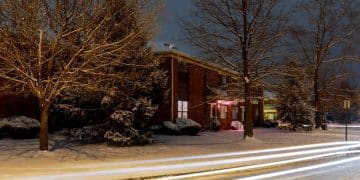Understanding the Polar Vortex: Impact on US Winter Weather

Understanding the polar vortex is crucial for predicting and preparing for extreme winter weather patterns in the United States, as its behavior significantly influences temperatures and storm systems across the country.
Have you ever wondered why the US experiences such extreme winter weather? The answer often lies in the behavior of the polar vortex, a large area of low pressure and cold air surrounding both of Earth’s poles. When this vortex weakens, it can send frigid Arctic air southward, impacting winter weather patterns across the United States.
What is the Polar Vortex?
The polar vortex is a persistent, large-scale cyclone located near the Earth’s poles. It exists year-round but is strongest during the winter months when the temperature contrast between the poles and the mid-latitudes is greatest. Let’s delve into its components for better understanding the polar vortex.
Think of the polar vortex as a giant spinning top of cold air high up in the atmosphere, about 10 to 30 miles above the ground. It’s always there, but it gets stronger in the winter because there’s a bigger temperature difference between the Arctic and the warmer areas to the south.
Formation and Location
The polar vortex forms due to the large temperature difference between the Arctic and the mid-latitudes. This temperature gradient creates a strong pressure gradient, which in turn drives strong winds that circulate around the polar region. This vortex is typically located in the stratosphere, above the troposphere where our weather occurs.
Why It’s Important
The polar vortex is a significant feature of the global climate system. Understanding its dynamics can help us anticipate and prepare for extreme weather events. Changes in the vortex’s strength and position can have far-reaching effects on weather patterns around the world.

- Year-Round Phenomenon: The polar vortex is an atmospheric circulation pattern that exists throughout the year.
- Winter Intensification: It intensifies during the winter due to the increased temperature contrast between the Arctic and lower latitudes.
- Stratospheric Location: The vortex primarily resides in the stratosphere, a layer of the atmosphere above the troposphere.
- Impact on Weather: When disrupted, it can cause extreme cold outbreaks in mid-latitude regions.
In conclusion, the polar vortex is a critical component of the Earth’s climate system, influencing weather patterns on a global scale. Its formation, location, and intensity are all interconnected, making it a complex subject of study for meteorologists and climate scientists.
How the Polar Vortex Affects Winter Weather
The polar vortex itself isn’t new or unusual, but its behavior can have a direct impact on winter weather patterns, particularly in the United States. When the polar vortex is strong and stable, it keeps the cold air locked up in the Arctic. However, when it weakens or becomes ডিসplaced, frigid Arctic air can spill southward.
When the polar vortex is strong, most of the really cold air stays near the North Pole. But sometimes, something happens to weaken it, like a big weather system messing with the air pressure. When that happens, the vortex can stretch out and send blobs of super-cold air down towards the US.
Jet Stream Interaction
The jet stream, a fast-flowing air current in the upper atmosphere, plays a crucial role in the movement of weather systems. When the polar vortex weakens, it can disrupt the jet stream, causing it to meander more. These meanders can bring cold air southward and warm air northward, leading to unusual weather patterns.
Extreme Cold Outbreaks
One of the most noticeable effects of a weakened polar vortex is the occurrence of extreme cold outbreaks. As Arctic air spills southward, temperatures can plummet to dangerously low levels, leading to widespread disruptions and potential health risks.
- Jet Stream Disruption: A weakened polar vortex can disrupt the jet stream, causing it to meander more.
- Southern Air Spill: Frigid Arctic air can spill southward, leading to extreme cold outbreaks in the US.
- Temperature Drops: Temperatures can plummet to dangerously low levels, causing widespread disruptions.
- Weather Pattern Changes: Unusual weather patterns can emerge as warm air moves northward and cold air moves southward.
To summarize, the polar vortex’s interaction with the jet stream and its ability to unleash extreme cold outbreaks are key factors in how it affects winter weather patterns. Understanding these dynamics is essential for predicting and preparing for severe winter weather.
What Causes the Polar Vortex to Weaken?
Several factors can contribute to the weakening of the polar vortex, including atmospheric waves, sudden stratospheric warmings, and climate change. These influences can disrupt the vortex’s stability and lead to significant weather impacts.
Think of the polar vortex as a spinning skater. If someone pokes the skater, they might wobble or slow down. In the same way, different things in the atmosphere can “poke” the polar vortex, causing it to get weaker and less stable. Let’s find out what pokes understanding the polar vortex.
Atmospheric Waves
Atmospheric waves, also known as Rossby waves, are large-scale disturbances in the atmosphere that can propagate upward from the troposphere into the stratosphere. These waves can interact with the polar vortex, transferring energy and disrupting its circulation.
Sudden Stratospheric Warmings (SSWs)
Sudden stratospheric warmings are rapid increases in temperature in the stratosphere over the Arctic. These warmings can weaken the polar vortex, causing it to become displaced or even split into multiple vortices. SSWs are often associated with major cold weather events in the mid-latitudes.

- Energy Transfer: Atmospheric waves transfer energy and disrupt the polar vortex.
- Rapid Temperature Increases: Sudden stratospheric warmings cause rapid increases in temperature in the Arctic stratosphere.
- Vortex Displacement: These warmings can weaken the polar vortex, causing it to become displaced or split.
- Cold Weather Events: SSWs are often associated with major cold weather events in the mid-latitudes.
In conclusion, atmospheric waves and sudden stratospheric warmings are major players in the weakening of the polar vortex. These phenomena can destabilize the vortex, leading to significant disruptions in winter weather patterns.
Predicting Polar Vortex Events
Predicting polar vortex events is a complex task that relies on sophisticated weather models and data analysis. Meteorologists use a variety of tools and techniques to monitor the polar vortex and forecast its potential impacts on winter weather.
Predicting what the polar vortex will do is like trying to guess what a mischievous kid will do next. It’s tricky, but scientists use special computer programs and lots of information about the atmosphere to try and figure it out. This helps them prepare people for any crazy weather that might be coming.
Weather Models
Weather models are computer simulations of the atmosphere that use mathematical equations to predict future weather conditions. These models can simulate the behavior of the polar vortex and provide insights into its potential impacts on winter weather.
Data Analysis
Meteorologists also rely on data analysis to monitor the polar vortex. They use data from weather balloons, satellites, and surface observations to track the vortex’s position, strength, and structure. This data can help them identify potential warning signs of a weakening or डिसplaced polar vortex.
- Computer Simulations: Weather models use computer simulations to predict future weather conditions.
- Data Tracking: Meteorologists use data from various sources to track the polar vortex’s behavior.
- Warning Signs: This data helps identify potential warning signs of a weakening or डिसplaced vortex.
- Improved Forecasts: Advances in weather modeling and data analysis are improving our ability to predict polar vortex events.
In summation, predicting polar vortex events is a challenging but crucial task. By using weather models and data analysis, meteorologists can provide valuable insights into potential winter weather impacts, allowing communities to prepare and mitigate risks.
Preparing for Extreme Winter Weather
When the polar vortex unleashes its frigid air, it’s essential to take steps to protect yourself, your family, and your property. Preparing for extreme winter weather can help minimize the risk of injury, illness, and property damage.
When the polar vortex decides to send its chilly greetings, it’s a good idea to be prepared. Think of it like getting ready for a big storm – you want to make sure you have everything you need to stay safe and cozy. Here are some tips to help you get ready.
Home Preparation
Start by winterizing your home. Insulate pipes to prevent them from freezing and bursting, and seal any cracks or gaps in windows and doors to keep the cold air out. It’s also a good idea to have an emergency kit with supplies like flashlights, batteries, and non-perishable food.
Personal Safety
When venturing out in extreme cold, dress in layers to trap body heat and protect yourself from frostbite and hypothermia. Cover exposed skin, wear a hat and gloves, and avoid prolonged exposure to the cold.
- Pipe Insulation: Insulate pipes to prevent freezing and bursting.
- Sealing Cracks: Seal cracks in windows and doors to keep cold air out.
- Emergency Kit: Prepare an emergency kit with essential supplies.
- Layered Clothing: Dress in layers to trap body heat.
In conclusion, preparing for extreme winter weather involves taking proactive steps to protect your home and yourself. By following these tips, you can minimize the risks associated with cold outbreaks and stay safe during severe winter conditions.
The Future of the Polar Vortex and Climate Change
Climate change is expected to have complex and potentially significant effects on the polar vortex. While the exact nature of these effects is still uncertain, scientists are actively researching the links between climate change and polar vortex behavior.
Climate change is like a wild card – it can change almost everything, including the polar vortex, but we are not certain how it will affect understanding the polar vortex. Scientists are working hard to understand what might happen so we can be ready for it.
Potential Impacts
Some studies suggest that climate change could lead to more frequent and intense sudden stratospheric warmings, which could further weaken the polar vortex and increase the likelihood of extreme cold outbreaks in the mid-latitudes. Other studies suggest that changes in sea ice cover and atmospheric circulation patterns could also influence the polar vortex.
Ongoing Research
Scientists are using climate models and observational data to better understand the complex interactions between climate change and the polar vortex. This research is crucial for improving our ability to predict future winter weather patterns and prepare for potential impacts.
- Increased Warmings: Some studies suggest climate change could lead to more frequent and intense sudden stratospheric warmings.
- Sea Ice Changes: Changes in sea ice cover could influence the polar vortex.
- Atmospheric Circulation: Alterations in atmospheric circulation patterns could affect the polar vortex.
- Model Improvements: Scientists are using climate models to better understand these complex interactions.
In essence, the future of the polar vortex in a changing climate is a topic of ongoing investigation. By continuing to study the complex interactions between climate change and the polar vortex, we can better anticipate and prepare for future winter weather extremes.
| Key Point | Brief Description |
|---|---|
| ❄️ Polar Vortex | A large area of low pressure and cold air around Earth’s poles. |
| 🥶 Extreme Cold | Weakened vortex can cause frigid air to spill southward, impacting US. |
| 🌡️ Stratospheric Warming | Rapid Arctic temperature increases can displace or split the vortex. |
| 🏡 Preparedness | Winterize your home and prepare an emergency kit. |
Frequently Asked Questions
▼
The polar vortex, when stable, keeps cold air confined near the poles. When it weakens, it can send cold air southward, leading to colder temperatures and extreme weather events in mid-latitude regions.
▼
Yes, climate change can influence the polar vortex. Some studies suggest that it may lead to more frequent sudden stratospheric warmings, which can weaken the polar vortex and increase cold outbreaks.
▼
Sudden stratospheric warmings (SSWs) are rapid increases in temperature in the stratosphere over the Arctic. These events can disrupt the polar vortex and lead to significant weather impacts in mid-latitude regions.
▼
To prepare, winterize your home by insulating pipes and sealing cracks. Also, have an emergency kit with supplies like flashlights, batteries, and non-perishable food. Dress in layers when going outside in extreme cold.
▼
No, the polar vortex is not a new phenomenon. It is a persistent, large-scale cyclone located near the Earth’s poles that exists year-round, though it is strongest during the winter months.
Conclusion
In conclusion, understanding the dynamics of the polar vortex is essential for predicting and preparing for extreme winter weather patterns in the United States. While the polar vortex itself is a natural phenomenon, its behavior can be influenced by various factors, including atmospheric waves, sudden stratospheric warmings, and climate change. By monitoring and studying the polar vortex, meteorologists can provide valuable insights into potential winter weather impacts, helping communities stay safe and informed.





